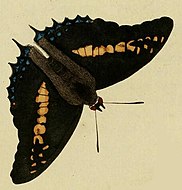Charaxes castor
| Charaxes castor | |
|---|---|

| |
| Giant emperor, Male | |
| Scientific classification | |
| Domain: | Eukaryota |
| Kingdom: | Animalia |
| Phylum: | Arthropoda |
| Class: | Insecta |
| Order: | Lepidoptera |
| Family: | Nymphalidae |
| Genus: | Charaxes |
| Species: | C. castor
|
| Binomial name | |
| Charaxes castor | |
| Synonyms | |
| |
Charaxes castor, the giant emperor or giant charaxes, is a butterfly of the family Nymphalidae. It is found throughout the Afrotropical realm below the Sahel.[2]
The wingspan is 75–85 mm in males and 85–105 mm in females. The flight period is year-round but more common in late summer to autumn.[3]
Description
A full description is given by Walter Rothschild and Karl Jordan, 1900 Novitates Zoologicae Volume 7:287-524. [1] page 436 et seq. (for terms see Novitates Zoologicae Volume 5:545-601 [2])
-
C. castor Female dorsal, from Maka, Central African Republic
-
C. castor Male ventral, from the Central African Republic
-
C. castor male
Natural History
Life-sized colour plates and description of the larval and pupal stages of C. castor and additional related species, illustrated by Dr. V. G. L. van Someren, are readily available.[4]
Larval fooplants
Larvae feed on Bridelia micrantha, Afzelia quanzensis, Tragia spp., Gymnosporia spp., Maytenus senegalensis, Schotia brachypetala, Bridelia micrantha and Cassia fistula.[2][3]
Subspecies
Listed alphabetically.[2]
- C. c. arthuri van Someren, 1971 (Pemba island)
- C. c. castor (Cramer, [1775]) (throughout African range)
- C. c. comoranus Rothschild, 1903 (Comoros)
- C. c. flavifasciatus Butler, 1895 (eastern Kenya, northern and eastern Tanzania, Malawi, Mozambique, eastern Zimbabwe, South Africa, Swaziland)
Related Species
Historical attempts to assemble a cluster of presumably related species into a "Charaxes jasius Group" have not been wholly convincing. More recent taxonomic revision,[5] corroborated by phylogenetic research, allow a more rational grouping congruent with cladistic relationships. Within a well-populated clade of 27 related species sharing a common ancestor approximately 16 mya during the Miocene,[6] 26 are now considered together as The jasius Group.[5] One of the two lineages forms a robust clade of seven species sharing a common ancestor approximately 2-3 mya, i.e. during the Pliocene,[6] and are considered as the jasius subgroup.[5]
The jasius Group (26 Species)
Clade 1: jasius subgroup (7 species):[5]
- Charaxes jasius
- Charaxes epijasius [stat.rev.2005][5]
- Charaxes legeri
- Charaxes saturnus [stat.rev.2005][5]
- Charaxes pelias
- Charaxes castor
- Charaxes hansali
Clade 2: contains the well-populated three additional subgroups (19 species) of the jasius Group, called the brutus, pollux, and eudoxus subgroups.[5] Further exploration of the phylogenetic relationships amongst existing Charaxes taxons is required to improve clarity.
References
- ^ Afrotropical Butterflies: File H - Charaxinae - Tribe Charaxini
- ^ a b c "Charaxes Ochsenheimer, 1816" at Markku Savela's Lepidoptera and Some Other Life Forms
- ^ a b Woodhall, Steve (2005). Field Guide to Butterflies of South Africa. Cape Town, South Africa: Struik. ISBN 978-1-86872-724-7.
- ^ van Someren, V.G.L.; Rogers, Rev. K. St. A. (1928). "The Butterflies of Uganda and Kenya (Part 7) Family Nymphalide - Charaxidi" (PDF). Journal of the East Africa and Uganda Natural History Society. 31–32: 111–113 & 136–138. hosted by Biodiversity Heritage Library (BHL)
- ^ a b c d e f g Turlin, B. (2005). Bauer & Frankenbach (ed.). Butterflies of the World: Charaxes 1. Vol. 22. Keltern: Goecke & Evers. pp. 2–3. ISBN 3937783156.
- ^ a b "Out of Africa again: A phylogenetic hypothesis of the genus Charaxes (Lepidoptera: Nymphalidae) based on five gene regions". Aduse-Poku, Vingerhoedt, Wahlberg. Molecular Phylogenetics and Evolution (2009) 53;463–478
External links
- Charaxes castor castor images at Consortium for the Barcode of Life
- Charaxes castor comoranus images at BOLD
- Charaxes castor flavifasciatus images at BOLD
- Images of C. castor castor Royal Museum for Central Africa (Albertine Rift Project)
- African Butterfly Database Range map via search



